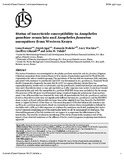| dc.contributor.author | Kamau, Luna | |
| dc.contributor.author | Agai, Derek | |
| dc.contributor.author | Matoke, Damaris | |
| dc.contributor.author | Wachira, Lucy | |
| dc.contributor.author | Gikandi, Geoffrey | |
| dc.contributor.author | Vulule, John M | |
| dc.date.accessioned | 2015-06-18T07:32:13Z | |
| dc.date.available | 2015-06-18T07:32:13Z | |
| dc.date.issued | 2008 | |
| dc.identifier.citation | Journal of Insect ScienceVolume 8, Issue 1, 2008 | en_US |
| dc.identifier.uri | http://jinsectscience.oxfordjournals.org/content/8/1/11 | |
| dc.identifier.uri | http://hdl.handle.net/11295/85091 | |
| dc.description.abstract | The status of resistance was investigated in Anopheles gambiae sensu lato and An. funestus (Diptera: Culicidae) mosquitoes from western Kenya to four classes of insecticides approved by World Health Organization for indoor residual spraying. The prevalence of the knockdown-resistance (kdr) mutation associated with resistance to pyrethroids and DDT was determined in An. gambiae s.l.. Standard World Health Organization diagnostic bioassay kits for DDT (an organochlorine), fenitrothion (an organophosphate), bendiocarb (a carbamate), and the pyrethoirds, lambdacyhalothrin and permethrin, were used. Knockdown every 10 min and mortality 24 h after exposure were noted. Controls not treated with insecticides and with the susceptible An. gambiae KISUMU strain were included in the bioassays. The presence of the kdr gene was determined using a standard diagnostic polymerase chain reaction assay. Over 98% mortality was observed for tests with all insecticides for both An. gambiae s.l. and An. funestus. Knockdown rates were not significantly different between An. gambiae s.l. and the KISUMU strain control. 50% and 95% knockdown times were either slightly lower than those for the KISUMU strain or higher by factors of less than 1.6. The mean frequency of the East African kdr mutation was 24.7% in An. gambiae sensu strictu. Based on conventional criteria where susceptibility is defined by mortality rates >98% 24 h after exposure, no evidence for resistance was found, implying that vector control measures employing any of the insecticides tested would be unhampered by resistance. The observed frequencies of the kdr mutation do not appear to compromise the effectiveness of the insecticides. The need for continuous monitoring of the status of insecticide resistance and of the impact of any observed resistance on the efficacy of vector control programs employing insecticides is apparent. | en_US |
| dc.language.iso | en | en_US |
| dc.subject | Diagnostic bioassays | en_US |
| dc.subject | Knockdown rates | en_US |
| dc.subject | Percentage mortality | en_US |
| dc.subject | Knockdown resistance gene | en_US |
| dc.title | Status of insecticide susceptibility in Anopheles gambiae sensu lato and Anopheles funestus mosquitoes from Western Kenya | en_US |
| dc.type | Article | en_US |
| dc.type.material | en_US | en_US |

